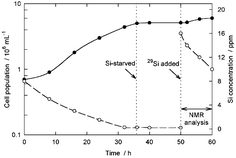Cultures of the freshwater diatom Navicula pelliculosa were synchronized by silicon starvation, fed a 29Si-enriched silicate solution, and then studied by 29Si NMR spectroscopy. Two NMR resonances could be detected reproducibly, the ever-present orthosilicic acid peak at −71 ppm and a weak signal at −131.5 ppm that was only seen after the diatoms had been allowed six hours to accumulate the 29Si. When the initial culture medium was enriched in 15N, the −131.5 ppm resonance narrowed significantly which, taken with the peak's unique chemical shift, implies the existence of an organosilicon complex containing hexavalent silicon coordinated to at least one nitrogen. The signal is the first direct evidence of an organosilicon complex formed during the life cycle of an organism.
You have access to this article
 Please wait while we load your content...
Something went wrong. Try again?
Please wait while we load your content...
Something went wrong. Try again?


 Please wait while we load your content...
Please wait while we load your content...